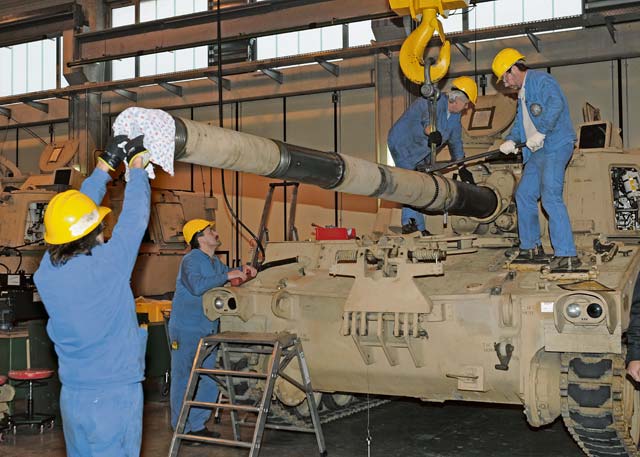
VILSECK, Germany — With the U.S. Army’s European Rotational Force in full swing and units continually rotating throughout Europe to train and work with allied partners, it is the responsibility of the Army Field Support Battalion-Germany, 405th Army Field Support Brigade, 21st Theater Sustainment Command to make sure the equipment Soldiers will work with are ready and operational.
Maintenance of the European Activity Set equipment, which stays in Europe and is issued to units training throughout the continent, takes the coordination of multiple agencies to ensure they are mission ready for future rotations throughout Europe.
Recently, the AFSBn-Germany received word from the Department of the Army that the eight M-109A6 Howitzers maintained by AFSBn-Germany required the replacement of their tubes prior to being operational for future use.
“A message came out from DA stating that if there is any pitting within the tubes, then they require replacement,” said Curtis Dabney, support operations officer with AFSBn-Germany. “Until the tubes are replaced, we cannot fire them, because it will degrade the life expectancy of the system as well as put Soldiers’ safety at risk.”
The replacement of the tubes, which is currently underway, has relied heavily on the coordination between AFSBn-Germany, the U.S. Army Tank Automotive and Armament Command, the 16th Sustainment Brigade’s 317th Maintenance Company, and the Theater Logistics Support Center-Europe’s Maintenance Activity Europe.
“Normally, we have our own EAS workforce that would do the work, however, because of the manhours required and the condition of the equipment, we had to pass some of the maintenance on to the 317th, which then passed it off to the MAV,” Dabney said.
In total, it takes approximately 40 hours to replace each tube from start to finish, and at more than 4,000 pounds each, it takes a skilled crew to ensure the replacement is done correctly and safely, not only for the MAV crew working on the tubes, but for the future Soldiers that will train on the system as well.
“If the tube isn’t replaced properly, it can have catastrophic consequences for the crew operating it,” said James R. Garner, logistics assistance representative from TACOM. “However, because of the experience level of the crew working on the Howitzers, I have the utmost confidence everything is being done correctly.”
Up to this point, the tube replacements have been going well with little to no problems the MAV and AFSBn-Germany have not been prepared for.
When it comes to challenges, “there hasn’t been anything systemic,” Dabney said. “There have been some small things that happened on this day or that day, but we have the resources to resolve it. It hasn’t been a big deal.
“Every maintenance organization is driven by the logistical supply system to get repair parts,” Dabney added. “That has probably been a bigger challenge than any daily operational challenges we’ve come across. Daily operational challenges are easy to fix.”
The final step in the tube replacement will be for a field artillery team to fire a test round from the Howitzers sometime in the near future. The test round will not only ensure the tubes were replaced properly, but also serve as the final replacement act, properly seating the tube into its housing.


